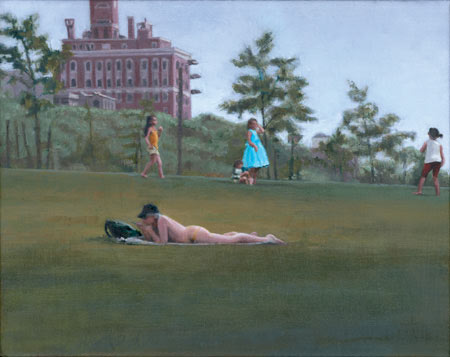
Laura Karetzky’s exhibition titled “Said What?” introduces a series of paintings that at first glance depict fairly common scenes from daily life. On closer inspection though, nothing is ever just what it seems. She has created scenarios where everything is somewhat skewed, anything possible and double takes are the order of the day.
Empathy will come in handy when contemplating “Ruza as an Eitel,” a painting showing an attractive young woman peering into a mirror that vaguely reflects her own image and that of her surroundings in an abstracted, funhouse mirror way. The woman raises her hand holding a pen or a stick of chalk. Is she making things up or is the world really upside down? The term “eitel,” alludes to vanity, but here it’s not about beauty but about a woman’s attempt to maintain a sense of self in a world that increasingly resembles a somewhat perverse amusement park.
An outward peace prevails in “Empire Fulton,” where a nude of undetermined gender reposes on a public lawn, oblivious to equally disconnected passersby, including a small child. A carefully articulated background suggests a place that still allows an individual to find a measure of contentment in however absurd a manner. The painting brings to mind Eric Fischl’s nudes placed into offbeat settings, but Karetzky surpasses Fisch’ls sensibilities which, in his early works at least, resembled those of an adolescent male.
“Old City Falls” has a similar, albeit more ominous vibe. Three figures are finding a tenuous path along a rock ledge bordering a roiling body of water. Losing their footing could result in a harmless swim or doom. And yet the trio exudes a sense of oblivion to their surroundings and each other. By painting the figures in stark relief to the monochromatic rocks and greenery, Karetzky creates the suspenseful atmosphere of a film clip.
One might consider snippets of memory as they occur in dreams or thought processes fragmented by either too much stimulation or not enough (“Marron Atrium”). It’s a collage of images acquired in an environment that is becoming visually saturated.
Her characters - women for the most part - are isolated. Physical and emotional encapsulation is suggested in “Michigan Ave.,” where a young woman looks out at the viewer from a darkened car, which serves as refuge — a room of her own, so to speak. Then again, “Ache,” featuring a man contemplating an open window or door, evokes instant empathy. The figure is dark and more suggested than fully realized. A sketchy background can be interpreted as another world, both physically and spirituality. A grayish-blue palette emphasizes a sense of pain, yet also creates a sense of the surreal.
Several paintings address not only issues of women’s self-perception but also their convoluted relationships to each other, as in “Cold Spring.” “Wall Space” is particularly powerful in its allusion to the interaction, or lack thereof, between generations and the inevitable passing of power between youthful and older women in a male/youth dominated culture.
Karetzky is a refreshingly subtle painter and teller of complex stories in which she gives just enough away without depriving viewers the chance to intersperse their own.
Published courtesy of ArtSceneCal ©2011
